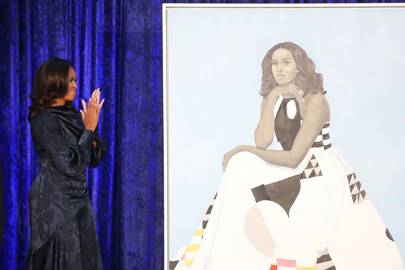Barack's portrait was painted by Kehinde Wiley, an artist best known for his vibrant, large-scale paintings of African-Americans, in which the subjects sit in fantastic, often ornate settings. Michelle’s was painted by Amy Sherald, a Baltimore-based artist known for her vibrant use of colour and for giving her predominantly African-American subjects a greyscale skin tone.
Of course, the moment was significant for many reasons – its modernity, patronage of African-American art, bold use of colour, the flower-wall! – but also for the dress worn by Michelle Obama. The full-length style, which has a graphic sensibility which distinguishes it from traditional formal gowns, is just as much a part of the painting as the sitter.
The designer of the dress in question is a lesser-known American label called Milly, which has previously been worn by Michelle Obama on official engagements, as well as a roll call of celebrities including Beyoncé, Gwyneth Paltrow and Emily Blunt. It’s known for its accessible wardrobe staples, like statement sweaters and flouncy blouses or ruffled dresses with wraparound waists.
Milly is the brainchild of designer Michelle Smith, who studied at the Fashion Institute of Technology in New York before starting Milly in 2000 after working in Paris at prestigious houses including Christian Dior, Louis Vuitton and Hermès. As a result, her label revolves around a contemporary combination of American sportswear with Parisian elegance. It’s also a family affair – Smith’s husband, Andrew, is her business partner and her young children have often accompanied as she takes a bow with her at the end of her shows at New York Fashion Week.
Of course, the moment was significant for many reasons – its modernity, patronage of African-American art, bold use of colour, the flower-wall! – but also for the dress worn by Michelle Obama. The full-length style, which has a graphic sensibility which distinguishes it from traditional formal gowns, is just as much a part of the painting as the sitter.
The designer of the dress in question is a lesser-known American label called Milly, which has previously been worn by Michelle Obama on official engagements, as well as a roll call of celebrities including Beyoncé, Gwyneth Paltrow and Emily Blunt. It’s known for its accessible wardrobe staples, like statement sweaters and flouncy blouses or ruffled dresses with wraparound waists.
Milly is the brainchild of designer Michelle Smith, who studied at the Fashion Institute of Technology in New York before starting Milly in 2000 after working in Paris at prestigious houses including Christian Dior, Louis Vuitton and Hermès. As a result, her label revolves around a contemporary combination of American sportswear with Parisian elegance. It’s also a family affair – Smith’s husband, Andrew, is her business partner and her young children have often accompanied as she takes a bow with her at the end of her shows at New York Fashion Week.

“It’s made of a stretch cotton poplin print in a clean, minimal, geometric print without a reference to anything past or nostalgic, which gives the dress a very forward-thinking sensibility – that is very Michelle Obama.”
At the portrait’s unveiling, Amy Sherald — the artist responsible for it — spoke about how the dress reminded her of a quilt from Gee’s Bend — a remote all-black community in Alabama that became known for its craft. She added that the colours were reminiscent of Piet Mondrian’s paintings, known for their geometric use of primary hues.
What is most striking about the portrait, however, is its overwhelming modernity, not only in the choice of artist and designer — but in the portrait itself. In every way, it is a contrast to the previous presidential portraits that it will sit with in the National Portrait Gallery’s complete collection in Washington DC. Michelle Obama is depicted leaning forward. She is regal and graceful, resting her head on her hand. Above all, her long hair is worn down and her arms are bare. Both of these elements assert a youthfulness and dynamism rarely seen in presidential portraiture.
Mrs Obama put it best herself when she spoke of the portrait’s importance. “I’m thinking about all the young people – particularly girls, and girls of colour – who in years ahead will come to this place and look up and see an image of someone who looks like them hanging on the wall of this great American institution,” said the former First Lady at the unveiling. “I know the kind of impact that will have on their lives because I was one of those girls.”
Mrs Obama put it best herself when she spoke of the portrait’s importance. “I’m thinking about all the young people – particularly girls, and girls of colour – who in years ahead will come to this place and look up and see an image of someone who looks like them hanging on the wall of this great American institution,” said the former First Lady at the unveiling. “I know the kind of impact that will have on their lives because I was one of those girls.”

No comments:
Post a Comment